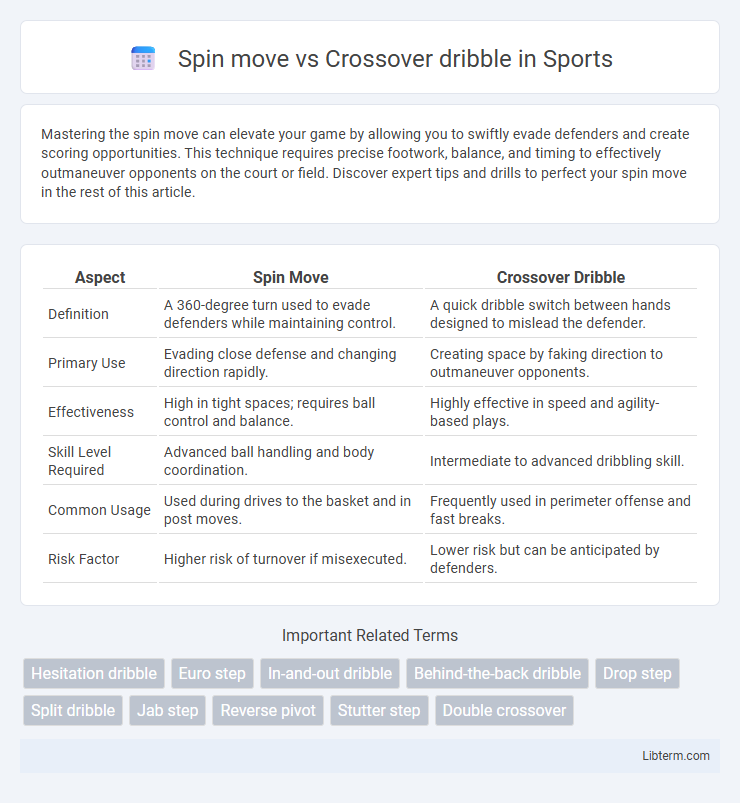Mastering the spin move can elevate your game by allowing you to swiftly evade defenders and create scoring opportunities. This technique requires precise footwork, balance, and timing to effectively outmaneuver opponents on the court or field. Discover expert tips and drills to perfect your spin move in the rest of this article.
Table of Comparison
| Aspect | Spin Move | Crossover Dribble |
|---|---|---|
| Definition | A 360-degree turn used to evade defenders while maintaining control. | A quick dribble switch between hands designed to mislead the defender. |
| Primary Use | Evading close defense and changing direction rapidly. | Creating space by faking direction to outmaneuver opponents. |
| Effectiveness | High in tight spaces; requires ball control and balance. | Highly effective in speed and agility-based plays. |
| Skill Level Required | Advanced ball handling and body coordination. | Intermediate to advanced dribbling skill. |
| Common Usage | Used during drives to the basket and in post moves. | Frequently used in perimeter offense and fast breaks. |
| Risk Factor | Higher risk of turnover if misexecuted. | Lower risk but can be anticipated by defenders. |
Introduction to Spin Move and Crossover Dribble
The spin move and crossover dribble are fundamental basketball techniques used to evade defenders and create scoring opportunities. The spin move involves a 360-degree pivot, allowing a player to swiftly change direction and maintain ball control under pressure. The crossover dribble, characterized by a quick switch of the ball from one hand to the other, exploits defender's hesitation to gain an advantage on the court.
Defining the Spin Move: Mechanics and Purpose
The spin move is a basketball technique involving a 360-degree pivot on one foot to evade defenders and create scoring opportunities. Its mechanics emphasize rapid footwork, body control, and the ability to maintain ball protection while rotating. The primary purpose of the spin move is to bypass opponents efficiently by using momentum and deceptive motion, contrasting with the crossover dribble's lateral ball-handling shift.
Understanding the Crossover Dribble: Key Elements
The crossover dribble involves swiftly switching the ball from one hand to the other to deceive defenders and create space for a shot or drive. Key elements include quick hand speed, low body stance, and sharp change of direction to maintain balance and control while confusing the opponent. Mastering the crossover requires precise timing and reading the defender's movements to maximize effectiveness.
Historical Impact of Spin Moves and Crossovers in Basketball
The spin move and crossover dribble have significantly shaped basketball's evolution by enhancing offensive creativity and defensive challenges. Pioneered by legendary players like Tim Hardaway for the crossover and Nate Archibald for the spin move, these techniques revolutionized ball handling and scoring strategies from the 1970s onward. Their widespread adoption across all levels of play underscores their enduring influence on basketball's dynamic style and player agility development.
When to Use Spin Move vs. Crossover Dribble
The spin move is most effective when closely guarded defenders trap your dribble, allowing you to swiftly change direction and evade the defender's reach with a quick 360-degree turn. The crossover dribble excels in situations where you want to create space and off-balance the defender by rapidly shifting the ball from one hand to the other, ideal for exploiting lateral defensive weaknesses. Use the spin move to maintain momentum through tight defensive pressure, while the crossover dribble is better suited for initiating offensive drives and creating shooting opportunities.
Advantages of the Spin Move in Game Situations
The spin move offers a powerful advantage in game situations by allowing players to quickly change direction while maintaining forward momentum, making it difficult for defenders to predict and react. This move creates space for an effective drive to the basket or a clear passing lane, boosting offensive fluidity. Its continuous motion minimizes ball exposure, reducing the risk of turnovers compared to the more static nature of the crossover dribble.
Benefits of the Crossover Dribble for Ball Handlers
The crossover dribble enhances ball handlers' ability to change direction quickly, creating space and confusing defenders with a sudden shift in speed and angle. This move improves agility, allowing players to exploit mismatches and drive lanes more effectively. Mastering the crossover dribble boosts offensive versatility, making it a critical skill for breaking defensive pressure and increasing scoring opportunities.
Common Mistakes in Executing Spin Moves and Crossovers
Common mistakes in executing spin moves include losing ball control due to improper hand placement and spinning too slowly, which allows defenders to anticipate the move. In crossover dribbles, frequent errors are poor foot positioning and telegraphing the direction change, making the move predictable. Mastering both techniques requires practicing quick, deceptive movements and maintaining a low center of gravity for better balance and control.
Training Drills to Master Both Techniques
Mastering spin moves and crossover dribbles requires focused training drills that enhance ball control, footwork, and agility. Cone drills combined with rapid direction changes build the necessary muscle memory for explosive spin moves, while practice sessions emphasizing quick hand switches and low dribbles improve crossover speed and deception. Incorporating shadow drills and one-on-one scenarios simulates game conditions, sharpening execution under defensive pressure and boosting overall offensive versatility.
Choosing the Right Move: Spin or Crossover for Maximum Effectiveness
Choosing between the spin move and crossover dribble depends on the defender's positioning and your offensive goal; the spin move excels at quickly changing direction to bypass aggressive defenders, while the crossover dribble is effective for creating space and disrupting defensive balance. The spin move generates momentum and can exploit close-guarded defenders by pivoting rapidly, making it ideal in tight quarters. In contrast, the crossover's lateral change of pace confuses defenders and opens shooting or driving lanes, making it optimal for isolations and setting up plays.
Spin move Infographic

 libterm.com
libterm.com